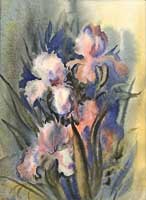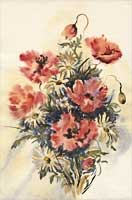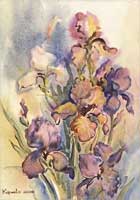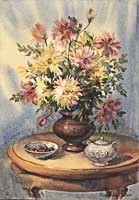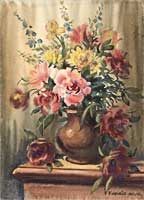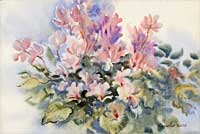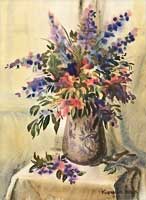 |
 |
|
 |
| A STILL LIFE is a work of art depicting inanimate subject matter, typically commonplace objects which may be either natural (flowers, game, sea shells and the like) or man-made (drinking glasses, foodstuffs, pipes, books and so on). Popular in Western art since the 17th century, still life paintings give the artist more leeway in the arrangement of design elements within a composition than do paintings of other types of subjects such as landscape or portraiture.
Still life paintings often adorn the walls of ancient Egyptian tombs. It was believed that the foodstuffs and other items depicted there would, in the afterlife, become real and available for use by the deceased. Similar paintings, more simply decorative in intent, have also been found in the Roman frescoes unearthed at Pompeii and Herculaneum. The popular appreciation of still life painting as a demonstration of the artist's skill is related in the ancient Greek legend of Zeuxis and Parrhasius.
Still life came into its own in the new artistic climate of the Netherlands in the 17th century. While artists found limited opportunity to produce the religious art which had long been their staple—images of religious subjects were forbidden in the Dutch Reformed Protestant Church—the continuing Northern tradition of detailed realism and hidden symbols appealed to the growing Dutch middle classes, who were replacing Church and State as the principal patrons of art in the Netherlands.
Especially popular in this period were vanitas paintings, in which sumptuous arrangements of fruit and flowers, or lavish banquet tables with fine silver and crystal, were accompanied by symbolic reminders of life's impermanence. A skull, an hourglass or pocket watch, a candle burning down or a book with pages turning, would serve as a moralizing message on the ephemerality of sensory pleasures. Often some of the luscious fruits and flowers themselves would be shown starting to spoil or fade. The popularity of vanitas paintings, and of still life generally, soon spread from Holland to Flanders, Spain, and France.
The French aristocracy of the 18th century also employed artists to execute paintings of bounteous and extravagant still life subjects, this time without the moralistic vanitas message of their Dutch predecessors. The Rococo love of artifice led to a rise in appreciation for trompe l'oeil (French: "fool the eye") painting, a type of still life in which objects are shown life-sized, against a flat background, in an attempt to create the illusion of real three dimensional objects in the viewer's space.
With the rise of the European Academies, most notably the Academie francaise which held a central role in Academic art, and their formalized approach to artistic training, still life began to fall from favor. The Academies taught the doctrine of "Hierarchy of genres" (or "Hierarchy of Subject Matter"), which held that a painting's artistic merit was based primarily on its subject. In the Academic system, the highest form of painting consisted of images of historical, Biblical or mythological significance, with still life subjects relegated to the very lowest order of artistic recognition.
|
|
 |
 |
Still life |
1
(Please click on image to see more detail .) |
|
|




